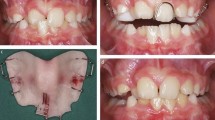Abstract
Design This was a single-centre two-phased, parallel, randomised clinical trial (RCT) conducted over a period of more than 10 years.
Intervention Children were enrolled who had severe (=7 mm overjet) Class II malocclusions and who were developmentally at least a year before their peak pubertal growth. During the first phase of the trial, the children were randomly assigned to either treatment starting in the mixed dentition (either combination headgear or a modified bionator) or to observation only. Phase-1 treatment was carried out by an orthodontist according to a standardised protocol. Records for all children were made again after 15 months. A second phase of comprehensive fixed-appliance treatment was planned for all the children when they had early permanent dentition. The children were then randomised, within their phase-1 treatment group, to one of four orthodontists for completion of orthodontic treatment (see Figure 1).
Outcome measure Primary outcomes were a restricted set of 11 cephalometric measures used to describe the position and relationship of the maxillary and mandibular skeletal and dental units. Secondary outcomes included the alignment and occlusion of the teeth [peer assessment rating (PAR) scores], the duration of treatment, and the proportion of children who required more complex treatment involving extractions or orthognathic surgery.
Results Of the 166 children who completed the first phase of the trial, 137 completed phase-2 with one of the four finishing clinicians. After the second phase, early treatment had little effect on the subsequent treatment outcomes — measured as skeletal change, alignment and occlusion of the teeth, or length and complexity of treatment. The differences created between the treated children and untreated control group by phase-1 treatment before adolescence disappeared when both groups received comprehensive fixed-appliance treatment.
Conclusions This RCT suggested that two-phase treatment started before adolescence in the mixed dentition might not be any more clinically effective than a single-phase treatment started during adolescence in the early permanent dentition. Early treatment also appears to be less efficient, in that it produced no reduction in the average time a child is in fixed appliances during a second stage of treatment, and it did not decrease the proportion of complex treatments involving extractions or orthognathic surgery.
Similar content being viewed by others
Commentary
The authors should be warmly congratulated on the completion of this 10-year trial. Its value could not be overestimated. It is the first prospective RCT on a large sample size in the orthodontic field that tested the justification of a long-held treatment philosophy. The outcome of this study will probably change the thinking of many clinicians in their treatment planning, and certainly will influence the treatment pattern here in Europe where Class II patients dominate orthodontic practice and where two-phase treatment is performed almost as routine.
The optimal timing for treatment of Class II malocclusions remains controversial. The effects of headgear and functional appliance as early-treatment methods are similar. They both work best when growth favours the treatment. The efficacy of early treatment has been affirmed in many studies but the question concerns efficiency: does a two-phase treatment provide superior results to a single-phase treatment?
Part of the controversy over the timing of treatment for Class II malocclusion comes from the differences between orthodontists in treatment beliefs. As a patient cannot be treated twice, one can never find out what would have happened if the alternative plan had been chosen. The best way to discover is to perform an RCT following children who have similar initial problems, with or without early treatment, through to late adolescence and the completion of comprehensive treatment in the permanent dentition. This is what this study was about.
The application of clinical trial methodology in this RCT is well performed according to the Critical Appraisal Skills Programme (CASP 2000). The possibility of generalisation from the results as well as the extent to which these results reflect those of usual clinical practice were thoroughly discussed. As the authors stressed, the conclusions cannot be extended to patients with different problems, ie, facial asymmetry or abnormal face height. Nevertheless, the answer to the principal question is clear: in many children with Class II malocclusion, early treatment is not justified in terms of treatment efficiency. Interestingly, the results imply that whether you treat them early or not, the outcome in certain patients will stay less-than-satisfactory and some patients will always need extraction or orthognathic surgery. Co-operation is not the only factor in determining the treatment outcomes and might not be the major one.
Practice points
There are currently very few indications to justify early treatment for Class II malocclusions.
-
Early treatment of Class II malocclusions is effective, but not efficient.
-
The difference in skeletal and dental morphology achieved in early treatment disappeared almost completely after comprehensive treatment with fixed appliance was completed.

Author information
Authors and Affiliations
Additional information
Address for correspondence: Dr JFC Tulloch, Department of Orthodontics, School of Dentistry, University of North Carolina, CB#7450, Brauer Hall, Chapel Hill NC 27599-7450, USA. E-mail: JFC_Tulloch@dentistry.unc.edu
Tulloch JFC, Proffit WR, Phillips C. Outcomes in a 2-phase randomised clinical trial of early Class II treatment. Am J Orthod Dentofacial Orthop 2004; 125:657–667
Rights and permissions
About this article
Cite this article
Ren, Y. Very few indications justify early treatment for severe Class II malocclusions. Evid Based Dent 5, 100–101 (2004). https://doi.org/10.1038/sj.ebd.6400288
Published:
Issue Date:
DOI: https://doi.org/10.1038/sj.ebd.6400288




